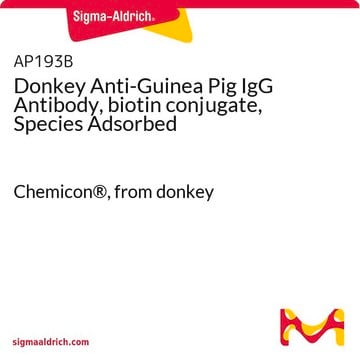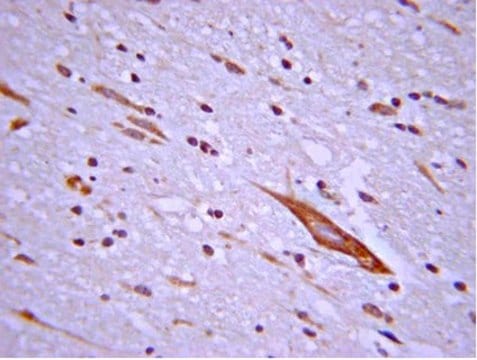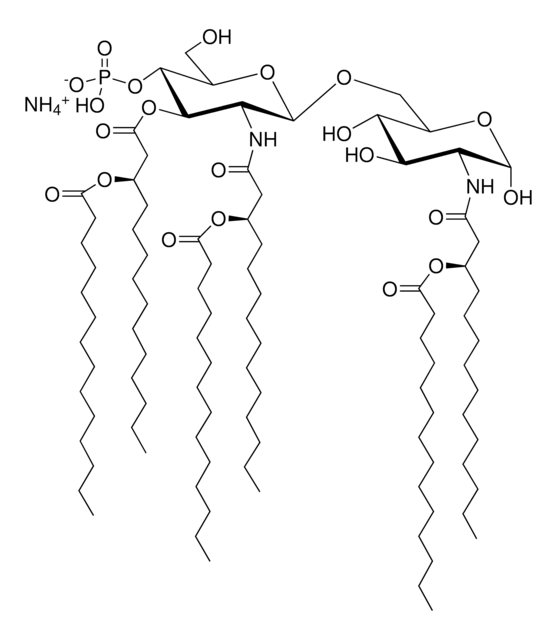Recommended Products
biological source
rabbit
Quality Level
antibody form
purified immunoglobulin
antibody product type
primary antibodies
clone
polyclonal
species reactivity (predicted by homology)
all
manufacturer/tradename
Chemicon®
technique(s)
ELISA: suitable
immunofluorescence: suitable
shipped in
wet ice
target post-translational modification
unmodified
General description
Protein isoprenylation is a post-translational modification that affects about 0.5% of cellular proteins and is essential for the biological activity of proteins. Two enzymes catalyze theattachment of two prenyl groups to the sulfhydryl group of carboxyl-terminal cysteine groups. Proteins which are prenylated by these enzymes have a distinct motif at the C-terminal of the protein, C-A1-A2-X (C = Cysteine, A 1 & A2 = aliphatic amino acids). The two enzymes involved in this transfer are farnesyltransferase and geranylgeranyltransferase. These transfer a 15 carbon farnesyl or a 20 carbon geranygeranyl, respectively, from aprenyl-pyrophosphate to the protein. Examples of proteins containing this C-A-A-X motif are members of the Ras small G protein family, the nuclear lamins and the gamma subunit oftrimeric G proteins. Prenylation of proteins is necessary for membrane association of proteins as well as protein-protein interactions and the nature of the linked isoprenyl group can influence the protein interactions, such as the interaction between G proteins and receptors.
Specificity
Recognizes farnesyl motif derived from isoprenylated C-A-A-X sequence. Also cross-reacts with geranylgeranyl motif. Detects KLH as well.
Immunogen
Antibody developed using farnesyl cysteine conjugated to KLH.
Application
Anti-Farnesyl Antibody detects level of Farnesyl & has been published & validated for use in ELISA & IF.
ELISA
Immunofluoresecence
Optimal working dilutions must be determined by end user.
Immunofluoresecence
Optimal working dilutions must be determined by end user.
Research Category
Signaling
Signaling
Research Sub Category
MAP Kinases
MAP Kinases
Physical form
Format: Purified
Purified immunoglobulin. Sterile liquid in phosphate buffered saline and 0.08% sodium azide.
Storage and Stability
Maintain at -20°C in undiluted aliquots for up to 12 months from date of receipt. Avoid repeated freeze/thaw cycles.
Other Notes
Concentration: Please refer to the Certificate of Analysis for the lot-specific concentration.
Legal Information
CHEMICON is a registered trademark of Merck KGaA, Darmstadt, Germany
Disclaimer
Unless otherwise stated in our catalog or other company documentation accompanying the product(s), our products are intended for research use only and are not to be used for any other purpose, which includes but is not limited to, unauthorized commercial uses, in vitro diagnostic uses, ex vivo or in vivo therapeutic uses or any type of consumption or application to humans or animals.
Not finding the right product?
Try our Product Selector Tool.
Storage Class Code
12 - Non Combustible Liquids
WGK
WGK 2
Flash Point(F)
Not applicable
Flash Point(C)
Not applicable
Certificates of Analysis (COA)
Search for Certificates of Analysis (COA) by entering the products Lot/Batch Number. Lot and Batch Numbers can be found on a product’s label following the words ‘Lot’ or ‘Batch’.
Already Own This Product?
Find documentation for the products that you have recently purchased in the Document Library.
Zurab Siprashvili et al.
Nature genetics, 48(1), 53-58 (2015-11-26)
Small nucleolar RNAs (snoRNAs) are conserved noncoding RNAs best studied as ribonucleoprotein (RNP) guides in RNA modification. To explore their role in cancer, we compared 5,473 tumor-normal genome pairs to identify snoRNAs with frequent copy number loss. The SNORD50A-SNORD50B snoRNA
Fei Liu et al.
Human molecular genetics, 24(16), 4648-4659 (2015-06-03)
Retinitis pigmentosa (RP) affects about 1.8 million individuals worldwide. X-linked retinitis pigmentosa (XLRP) is one of the most severe forms of RP. Nearly 85% of XLRP cases are caused by mutations in the X-linked retinitis pigmentosa 2 (RP2) and RPGR.
C Banfi et al.
Communications biology, 4(1), 1109-1109 (2021-09-23)
The research into the pathophysiology of atherosclerosis has considerably increased our understanding of the disease complexity, but still many questions remain unanswered, both mechanistically and pharmacologically. Here, we provided evidence that the pro-oxidant enzyme Prenylcysteine Oxidase 1 (PCYOX1), in the
Tsuyoshi Waku et al.
iScience, 24(10), 103180-103180 (2021-10-21)
Lipids, such as cholesterol and fatty acids, influence cell signaling, energy storage, and membrane formation. Cholesterol is biosynthesized through the mevalonate pathway, and aberrant metabolism causes metabolic diseases. The genetic association of a transcription factor NRF3 with obesity has been
Kazuhiro Shirozu et al.
Shock (Augusta, Ga.), 42(6), 570-577 (2014-07-22)
Acute liver failure (ALF) is a fatal syndrome associated with massive hepatocyte death. There is no cure for ALF except liver transplantation. Protein farnesylation is a lipid modification of cysteine residues that is catalyzed by farnesyltransferase (FTase) and has been
Our team of scientists has experience in all areas of research including Life Science, Material Science, Chemical Synthesis, Chromatography, Analytical and many others.
Contact Technical Service








